
FS-1157 | April 2021
Bottle Feeding Kids and Lambs
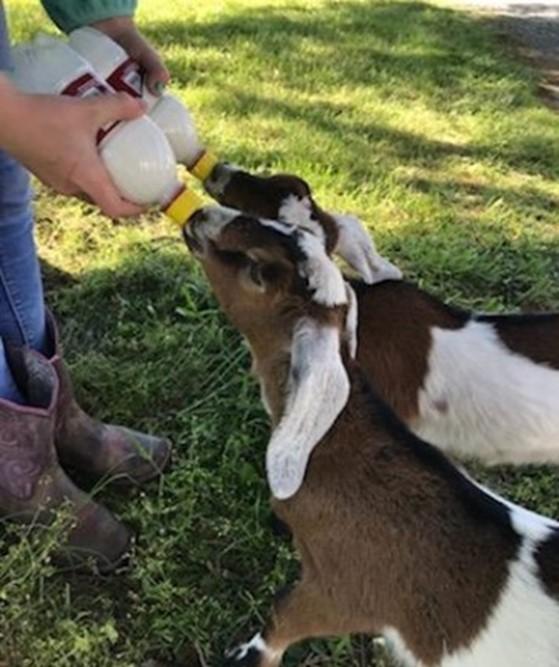
Many factors may require producers to bottle feed lambs and kids. For dairy goats, producers may opt to bottle feed as a biosecurity measure and to prevent damage to the does’ udders by nursing kids. As a result, many dairy goat kids are sold as bottle babies. Anyone purchasing dairy breed kids should be prepared to bottle feed them (Figure 1).
Orphaned kids and lambs will need to be bottle fed if they are not grafted on to another dam. Other reasons for bottle feeding are rejected kids and lambs, litters that are too large for the dam to feed, and weak or sick lambs and kids.
For animals with large litters, the babies may be able to stay with the dam and a few bottles given to the smaller babies each day. Does and ewes with large litters may be able to feed them for the first week or so, but as the demand for milk by their offspring increases, one of the lambs or kids may start to fall behind. Babies from large litters that need supplementing may stand hunched and get chilled. A chilled lamb or kid may lose its nursing reflex. In this situation, it will need to be tube fed until it is able to nurse. Hungry lambs or kids will generally accept a bottle; however, it may be harder to get an older a lamb or kid to accept a bottle the first time it is offered.
If a doe or ewe has a large litter and one or two must be pulled to bottle feed, producers need to consider a few factors. Often it is appropriate to pull and bottle feed the odd-sized lamb or kid. These may be a lot smaller or larger than the rest of the litter. Small lambs and kids may need extra help and benefit from being put on a bottle. Kids and lambs that are much larger than their littermates may overpower the rest of the litter. Lambs and kids matched closely in size should usually be left on their dam. If all lambs and kids are close in size, personal preferences may determine which are pulled for bottle feeding. For example, if one is being kept as a replacement female and having tame animals is desired, then that lamb or kid may be chosen.
Starting Lambs and Kids on the Bottle Usually Requires Patience

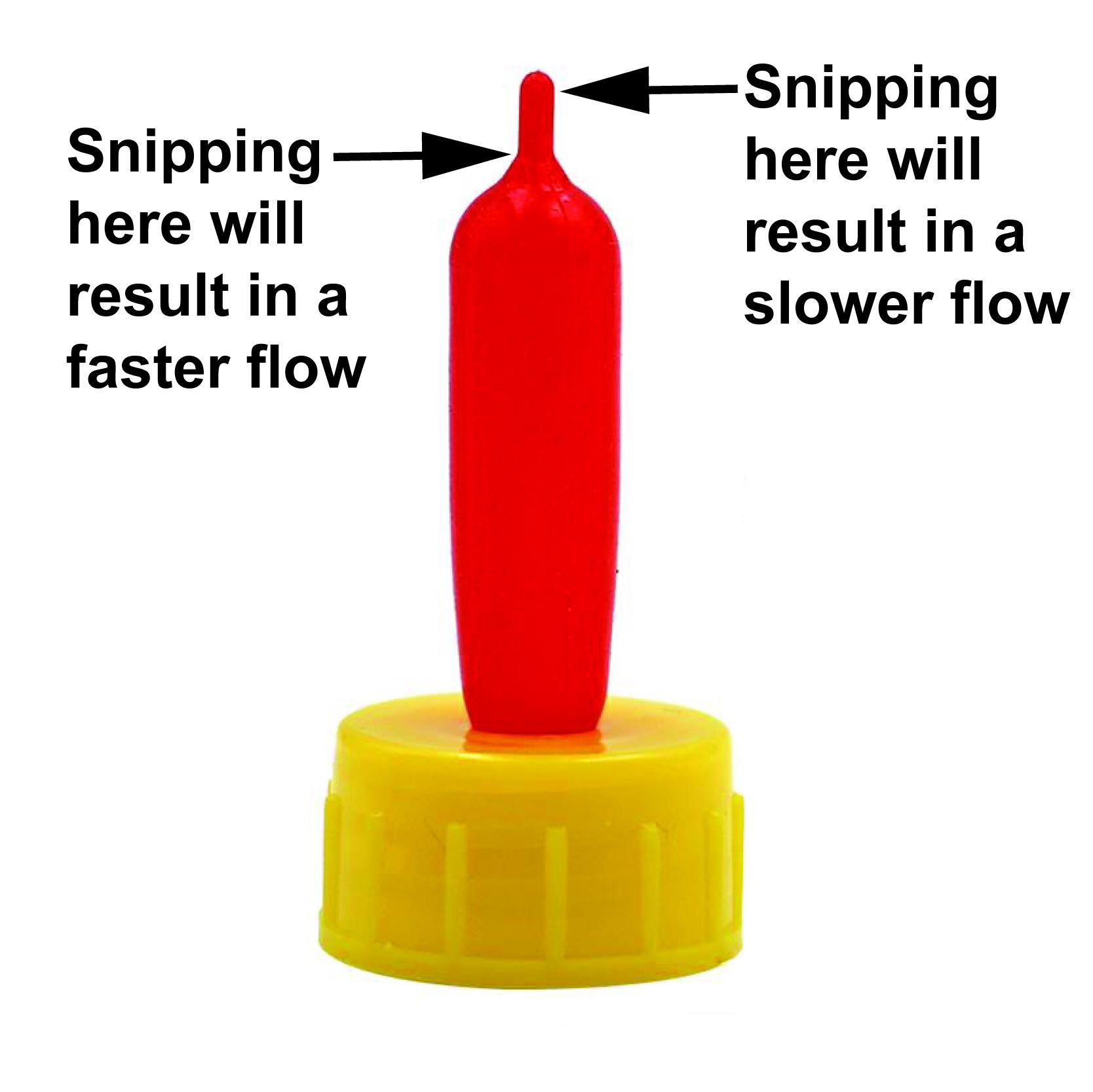
It is advisable to keep a few different types of teats and nipples on hand. Pritchard teats are a popular choice because they are designed for lambs and kids. These teats will fit on a soda bottle or you can purchase bottles specifically for the purpose (Figure 2a). The flow on Pritchard teats is determined by how the tip is cut. They are sold with a tip that is sealed. The tip can be cut with slits forming an “X”. This allows the tip to seal so that milk does not leak out if a lamb or kid is not actively nursing. The tip can also be snipped off. The tip gets wider as it gets closer to the teat. Cutting off the whole tip will result in faster flow (Figure 2b).
Human baby bottle nipples may work better for some newborns. The milk flow will be slower and the wider nipple is easier for some newborns to grasp with their tongues. These nipples may be closer to the nipples on bucket feeders. If the lambs or kids are going to be transitioned onto a lambar or bucket-type feeder, it may be easier to transition from human baby bottle nipples. A hungry lamb or kid should accept a bottle once it gets a taste of the milk. When introducing a newborn lamb or kid to a bottle, make sure that its tongue is wrapped around the teat. Some newborns have difficulty with this and will push their tongue out the side of their mouths. For newborns, it may be easier to introduce them to the bottle while they are seated in your lap.
Older lambs and kids being introduced to the bottle will usually only accept it while standing since that is how they learned to nurse from their dams. It may take quite a bit more patience to get an older lamb or kid to accept a bottle for the first time. It may be easier in small flocks where the adult animals are friendlier and have a smaller flight zone. Adding a small drop of honey to the teat may help.
Older orphans also may refuse a bottle if they do not like the taste, especially when offering milk replacer. If an orphan seems hungry and nurses from the bottle but refuses after a few swallows, try offering whole milk. Weak or hungry lambs and kids that refuse a bottle will need to be tube fed. Never drench or syringe feed lambs or kids, including dribbling or squirting milk into the lamb’s or kid’s mouth. This may cause them to aspirate it into their lungs. Hypothermic lambs and kids need to be warmed to normal body temperature prior to feeding.
Three Accepted Artificial Rearing Methods for Lambs and Kids
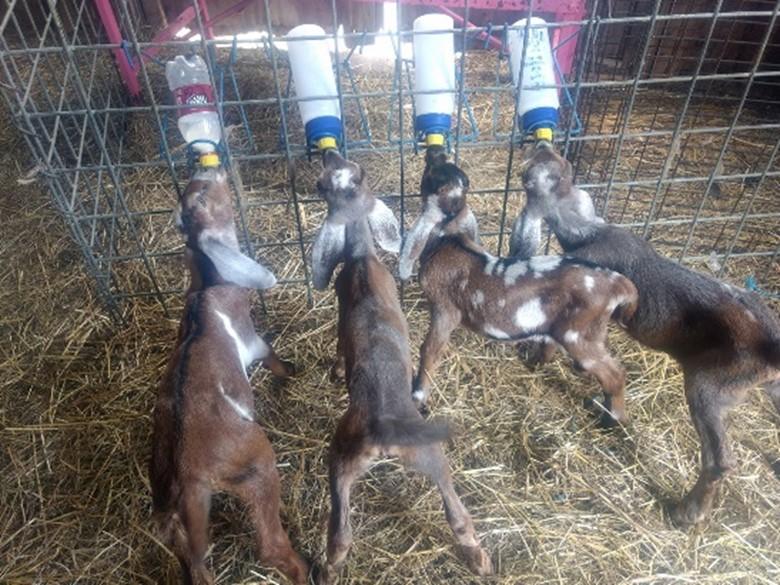
Bottle feeding, the most familiar artificial rearing method, is when a limited amount of milk is fed on a schedule. The amount of milk given at each feeding is based on the animal’s weight, while the number of daily feedings depends on the animal’s age. This is the only method where it is acceptable to feed warm milk. Bottle racks can be purchased or made to make bottle feeding multiple animals at the same time easier (Figure 3). Monitor animals to ensure that aggressive and older lambs and kids don’t finish their bottles and then steal from others.
One of the most common methods for larger small-ruminant operations is bucket feeding (Figure 4). Small ruminant bucket feeding refers to lambs and kids drinking milk from a system where nipples are attached to the bucket. This is also referred to as a lambar and it provides constant access to milk. This is a type of free choice or ad lib feeding. This method is preferred by many producers because it more closely mimics how lambs and kids eat from their dams–small quantities of milk several times a day.
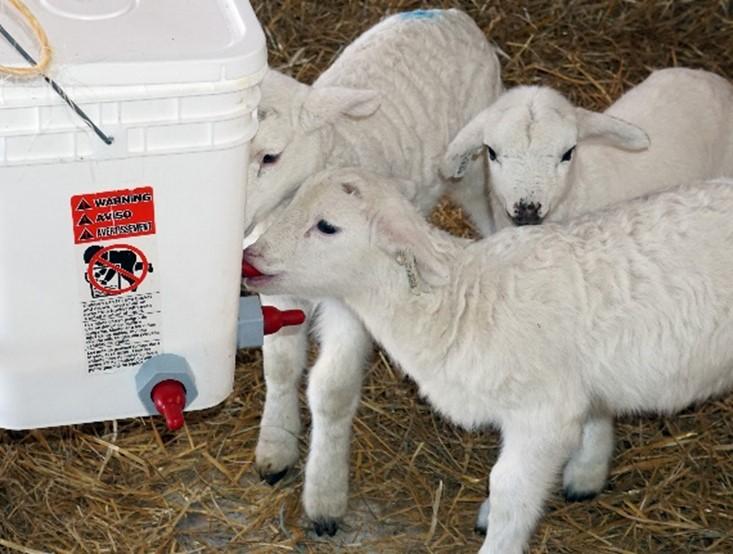
Milk must be kept cold so that it does not spoil and the babies do not overeat. There are several types of bucket feeders available from different manufacturers. Some have nipples placed at the bottom of the bucket and others have nipples near the top of the bucket with tubes that run to the bottom of the bucket. Buckets with tubes may be more difficult to keep clean. With this method, lambs or kids are fed milk with a bottle until they are strong enough to be trained to eat from the lambar or bucket feeder.
Pan feeding is another lesser-known type of limit feeding for lambs and kids. Lambs or kids are given a set amount of milk, but instead of using a bottle, they drink it from a pan or bucket. This system may work better for lambs and kids that are orphaned at older ages and refuse a bottle but are not quite old or large enough to be weaned onto hay and feed only. While the pan option makes cleaning equipment easier, drinking from a pan or pail is not optimal. When lambs and kids nurse from teats and nipples, the position of their heads and necks causes the esophageal groove to close and allows milk to bypass the rumen where it would undergo fermentation and go directly to the abomasum. Lambs and kids raised by pan feeding may show poor growth.
All Lambs and Kids Should be Given Colostrum as Soon as Possible after Birth
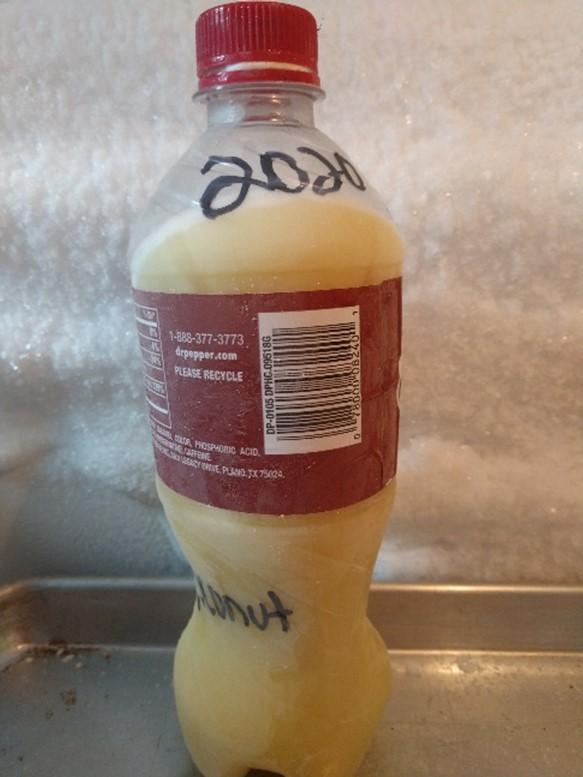
The best colostrum is from their dams. If that is not available, give colostrum from another ewe or doe on the farm. Lambs can get goat or cow colostrum if sheep colostrum is unavailable; however, lambs need a larger amount of cow colostrum since it has less fat than sheep colostrum. It is always best to use colostrum produced from animals on the same farm. Many producers will milk colostrum from does and ewes with excess and freeze it to use for orphans (Figure 5). Colostrum from another farm may be an option but could put your animals at risk for diseases. There is a risk of Johne’s disease when using cow colostrum.
If real colostrum is not available, there are colostrum replacers. Colostrum supplements are not adequate. Colostrum replacers contain IgGs (Figures 6 and 7).
Colostrum replacers may be difficult to tube feed since they are thick. Tube feeding thick colostrum may require using a plunger on the catheter tip syringe to force it through the tube. This is different than tube feeding milk which should be gravity fed.
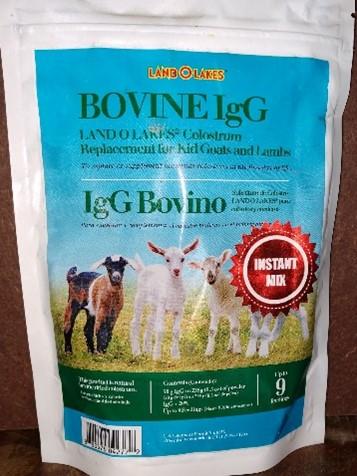
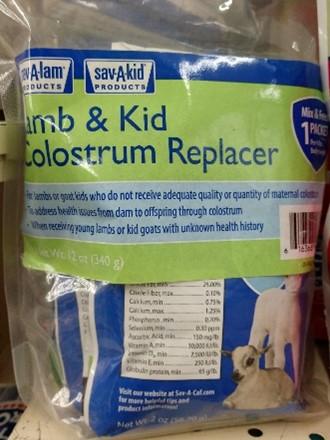
There are Several Options for Milk for Lambs and Kids
The best is fresh milk from the dam. The nutritional content of milk will change throughout the lactation cycle. More nutritious milk is produced at the beginning of the cycle when the kids and lambs are young. Another option is stockpiled, frozen milk. Frozen milk can be thawed as needed. Dairy goats and dairy sheep can be valuable assets on the farm for stockpiling milk for later use. It is important to note that lambs have a higher fat requirement than kids. One of the benefits of fresh milk is that there is no mixing involved.
Milk may separate when thawed if not frozen properly. To prevent milk from separating, it must be cooled quickly. Putting fresh milk in the refrigerator does not cool it quickly enough, so some producers put fresh milk directly in the freezer. If the milk separates when it is thawed, it must be mixed thoroughly prior to feeding to lambs or kids. Milk may be pasteurized for biosecurity reasons. There are different ways to pasteurize milk. It can be done with a pasteurizer, double boiler or on the stove top. To pasteurize milk, it must be heated to 165°F and held at that temperature for 15 seconds.
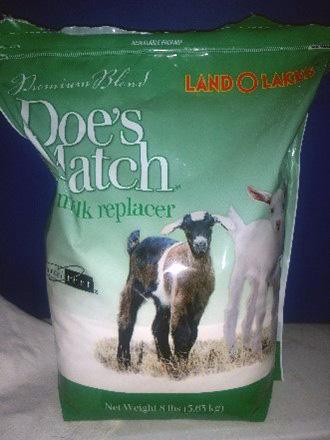
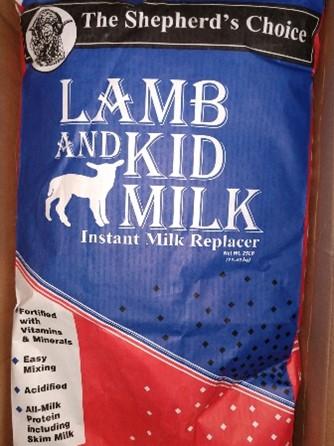
Species-specific milk replacer is the best option for artificially rearing baby animals (Figures 8 and 9). When choosing a milk replacer, select a high-quality milk replacer made with milk proteins for the species being fed. It is important to carefully follow the directions when mixing the milk replacer. The manufacturer will recommend a temperature for the water used to mix the milk replacer. Using the proper water temperature will help ensure that the powder is thoroughly dissolved. There is usually a measuring cup with the milk replacer. Measure the powder carefully with the enclosed cup or weigh the powder if the directions indicate the required pounds or ounces.
It is also helpful to have the same person mix the milk each time since people may interpret mixing directions differently. If a minor mixing error occurs, it will be a consistent error and reduce the risk of digestive upset. Combining the powder and water in a jug may work better for thoroughly mixing than stirring with a spoon or whisk. One of the major benefits of milk replacer is that there is no risk of transmitting diseases such as Caprine Arthritis Encephalitis (CAE), Ovine Progressive Pneumonia (OPP) and Johne’s disease.
You shouldn’t feed calf or multi-species milk replacer to lambs or kids. The higher lactose may cause abomasal bloat. Some good milk replacers may be labeled for both lambs and kids; however, the mixing directions will be different to account for the higher fat requirement of lambs. An advantage of milk replacers is that they can be purchased with a coccidiostat already added into it. This is a good option for farms that have had problems with coccidia which are single-celled protozoa that can cause coccidiosis in lambs and kids. Lambs and kids become infected by ingesting oocytes and are most at risk from 1 month to 6 months of age. Infected animals may show poor growth, dull coats, diarrhea and/or anemia.
Whole cow’s milk is an option. This can be obtained as waste milk from a dairy or purchased from the grocery store. To account for their higher fat requirement, extra fat or oil added should be added to the milk if it is being fed to lambs. As with milk replacers, it is important to mix the milk consistently if adding fat. When milk prices are low, store-bought milk may be cheaper than milk replacer.
Probiotics are good to keep on hand when bottle feeding. To prevent stomach upset, add the powder form to the milk if changes will be occurring to the feeding routine such as the quantity or type of milk. Adding powdered probiotics can help treat an upset stomach. Probiotics should never be used as insurance against sloppy mixing or feeding practices.
Follow Feeding Guidelines for Newborns
Colostrum is nutrient dense and contains antibodies that will protect the babies in the first few weeks of life. Newborns need to consume approximately 10% of their bodyweight of colostrum in the first 24 hours, the sooner the better. Colostrum should be heated to body temperature in a hot water bath prior to feeding. Never heat colostrum in the microwave because it will destroy the antibodies.
After the lambs or kids have received adequate colostrum, they can be switched to milk or milk replacer. They should receive four to six feedings a day for the first few days. These feedings can be decreased; however, more frequent feedings with smaller quantities of milk is the healthiest and safest option. It may take a few days for the babies to learn what the bottle is and not need any help taking the nipple. Lambs and kids should easily finish each feeding. It is better to leave them a little hungry than to overfeed. Feeding cold milk reduces the risk of abomasal bloat because they will not eat as fast and are less likely to overeat. If desired, lambs and kids of similar ages can be transitioned to bucket feeders once they are eating well. If they remain on bottles, the quantity at each feeding can be gradually increased as they get older, based on appetite. Feeding times should be consistent. Never go below two feedings per day until they are ready to wean.
Offer high-quality feed to lambs and kids by the time they reach a week old. The feed needs to be highly digestible (e.g. cracked corn and soybean meal) and contain at least 18 percent crude protein. Soybean meal can be a good starter feed. Bottle babies raised alone tend to take longer to start eating grain since there are no other animals for them to learn from. Offer hay by the time they are three weeks old. They should not be weaned and their milk should not be decreased until they start eating significant amounts of grain and forage. This may take six to eight weeks.
Cleanliness cannot be overemphasized when artificially raising lambs or kids. Keep bottles, teats and mixing equipment clean. Do not allow milk to go sour. Nipples and teats used to feed the lambs or kids should be checked frequently to ensure that they are in good condition. Over time, with frequent uses or improper care, the material can break down and the nipples and teats may weaken. This puts them at risk for being pulled apart, especially by older babies or aggressive nursing. If it pulls apart during feeding and the animal swallows the nipple, it may become a choking hazard. A good time to check nipples and other equipment for holes and weakness is during regular cleaning.
Never feed warm milk free choice. Kids and lambs will overeat warm milk which will result in upset stomach and/or abomasal bloat. One big mistake some well-intentioned owners do is offer warm water in the bottle if lambs or kids are still hungry after drinking their milk. This should never be done. Lambs and kids will drink too much water if offered through a bottle. This results in water toxemia. The usual symptom observed is bloody urine.
Water should always be available in a bucket or pan. As lambs or kids get older, they will begin to consume water as needed. They will require more water as they get older and start eating grains and hay. Milk should never be syringe fed or drenched. Tube feed lambs or kids that are unable to nurse. Tube feeding is an easy skill to learn and much safer than syringe feeding weak animals. Lambs and kids should only be fed if their body temperature is normal. If they are chilled or hypothermic, they should be warmed prior to feeding.
Target Weaning Age is Six Weeks
Bottle feeding is time consuming and can be expensive when purchasing milk replacers. Many producers look forward to weaning their bottle babies while others try to delay it. While it is possible to wean lambs and kids at 30 days, most bottle babies are not eating adequate amounts of feed by that age.
Lambs and kids must be eating adequate amounts of solid feed before they can be weaned. This is indicative of proper rumen development. Small ruminants’ stomachs have four compartments. At birth, the abomasum is the biggest compartment because lambs and kids are only eating milk. As they get older and start eating grain and forages, their rumen starts to develop and gets bigger compared to the abomasum. By weaning age, if lambs and kids have been eating feed and hay, the rumen will be the biggest compartment.
Lambs and kids should be given high-quality feed, preferably 18 to 20% crude protein. If coccidia is a concern, feed can be purchased with a coccidiostat already added in it. Lambs and kids should be consuming high-quality hay by the time they are ready to wean. Water should always be available. Once lambs or kids are consuming enough feed and have reached the appropriate weight (2.5 times their birth weights), they should be weaned off milk.
Weaning should be abrupt. To minimize stress during this time, do not make any other changes, such as changing pens or selling to another farm. Keeping them in familiar surroundings with other lambs and kids will help minimize stress. Bottle babies should be weaned for several weeks before they are sold to another farm. This will ensure that they are eating properly and give them time to recover from the weaning before adding the stress of moving to a new environment. Avoid stressful management practices such as vaccinations, tattooing, tagging and castration during this time.
Though it may be emotional for some producers, leaving lambs and kids on the bottle for too long may hurt them. Because they do not receive as much colostrum as dam-raised lambs and kids, bottle babies may need to start vaccinations at an earlier age. CDT vaccines can be given at 3-4 weeks. If lambs and kids are weaned at 6 weeks, they will have been weaned for one to two weeks before they need the booster vaccine. The first few months are very critical for growth in lambs and kids because they experience their best rate of gain. Proper feeding is critical, especially for replacement females that will be bred to lamb and kid as yearlings.
Artificial rearing can be a rewarding experience if done correctly. Consistency in the feeding schedule, the amount being fed or what is being fed, is important. Although a bottle baby may bond with people and other pets, when possible, they should bond with another lamb or kid. They will not stay small and will eventually return to the flock. Having a lamb or kid friend will make this transition easier; however, you will still have a close connection with them for years to come.
* Use of a product or brand is for an example only. It is not an endorsement.
MAEGAN PERDUE
mperdue@umd.edu
SUSAN SCHOENIAN
sschoen@umd.edu
This publication, Bottle Feeding Kids and Lambs (FS-1157), is a part of a collection produced by the University of Maryland Extension, Department of Agriculture and Food Systems (AgFS) within the College of Agriculture and Natural Resources.
The information presented has met UME peer-review standards, including internal and external technical review. For help accessing this or any UME publication contact: itaccessibility@umd.edu
For more information on this and other topics, visit the University of Maryland Extension website at extension.umd.edu
University programs, activities, and facilities are available to all without regard to race, color, sex, gender identity or expression, sexual orientation, marital status, age, national origin, political affiliation, physical or mental disability, religion, protected veteran status, genetic information, personal appearance, or any other legally protected class.